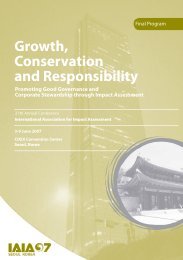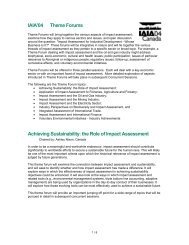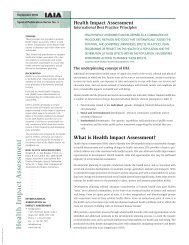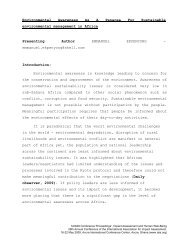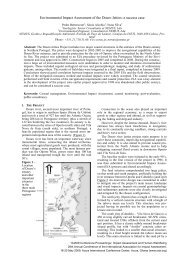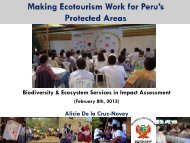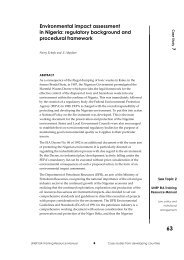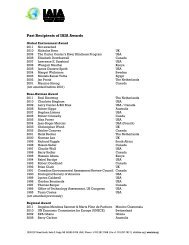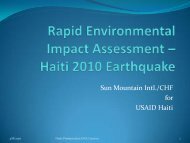Power, poverty and sustainability - International Association for ...
Power, poverty and sustainability - International Association for ...
Power, poverty and sustainability - International Association for ...
Create successful ePaper yourself
Turn your PDF publications into a flip-book with our unique Google optimized e-Paper software.
• IAIA06 Abstracts Volume •<br />
Gr<strong>and</strong>e, Darby; Delft University of Technology, Jaffalaan 5,<br />
Delft, 2628BX Netherl<strong>and</strong>s. 015 278 7468.<br />
d.e.gr<strong>and</strong>e@tbm.tudelft.nl<br />
Planning <strong>for</strong> the future of a nation’s energy infrastructure is<br />
fraught with major uncertainties. Scenarios are constructed<br />
worldwide as a tool to help decision-makers underst<strong>and</strong> <strong>and</strong><br />
begin to cope with such uncertainties, but it is not always<br />
clear what is best to be done today given a perhaps<br />
overwhelming number of future possibilities.<br />
In working to further transition to a sustainable energy<br />
infrastructure system in the Netherl<strong>and</strong>s, we discover that in<br />
many cases our visions of the future depend heavily on<br />
technology developments that are not certain. Taking into<br />
account these uncertainties, we argue that flexibility of the<br />
energy infrastructure today <strong>and</strong> in the near future is a<br />
desirable step toward eventual <strong>sustainability</strong>. We discuss the<br />
use of our analysis of scenarios existing in the literature to<br />
evaluate the flexibility of the energy system in The<br />
Netherl<strong>and</strong>s <strong>and</strong> the anticipated outcomes of various policy<br />
measures.<br />
Relocation of 1.778 MW Diesel Lamu <strong>Power</strong> Station<br />
from Lamu Isl<strong>and</strong> to Lamu Mainl<strong>and</strong> at Mokowe,<br />
Kenya–Impact Assessment<br />
Wetang’ula, Gabriel; Kenya Electricity Generatig Company,<br />
Olkaria Geothermal Project, Moi South Lake Road, P.O. Box<br />
785, Naivasha, 20117 Kenya. +254 50 50086.<br />
gwetangula@kengen.co.ke<br />
Kubo, Benjamin; Kenya Electricity Generatig Company,<br />
Olkaria Geothermal Project, Moi South Lake Road, P.O. Box<br />
785, Naivasha, 20117 Kenya. +254 50 50086.<br />
bkubo@kengen.co.ke<br />
Kenya’s national electric grid does not extend to Lamu<br />
District. Provision of electricity to the District is by 1.778 MW<br />
diesel power station situated on Lamu isl<strong>and</strong> operated by<br />
Kenya Electricity Generating Company (KenGen). KenGen<br />
plans to relocate the station from the isl<strong>and</strong> to the mainl<strong>and</strong>.<br />
This is necessary due to safety, environmental, operational<br />
<strong>and</strong> generation expansion requirements. The station only<br />
serves the isl<strong>and</strong> which is the main load center of the district<br />
due to tourism industry <strong>and</strong> district headquarters. There is<br />
unserved power of 1.5 MW on the mainl<strong>and</strong> due to lack of<br />
connectivity to the mainl<strong>and</strong> <strong>and</strong> lack of generation capacity<br />
expansion space. The station is a potential occupational<br />
hazard. Should fire occur in the station, this UNESCO World<br />
Heritage Site could be decimated. There are also limited fire<br />
fighting <strong>and</strong> evacuation facilities. The study identified by<br />
products of the project as wastewater, used lubrication<br />
oil,scrap metals <strong>and</strong> gaseous emissions. Positive impacts<br />
include availability of space <strong>for</strong> expansion, job creation,<br />
reduced environmental <strong>and</strong> safety risk. Potential negative<br />
impacts include population increase, disturbance of terrestrial<br />
ecology,increased soil erosion <strong>and</strong> health risks during<br />
construction phase. This will be mitigated as per the<br />
Environmental Management Plan.<br />
Deepwater LNG Terminal Development in the United<br />
States<br />
Sage, Paul; TECinc, 250 Bobwhite Court, Suite 200, Boise,<br />
Idaho 83702 USA. 208 389-7848. Fax 208 389-7849.<br />
pwsage@tecinc.com<br />
The U.S. Congress passed the Deepwater Port Act (DWPA) in<br />
1974. Fundamental to the intent of the DWPA was the need to<br />
meet the United States’ growing dem<strong>and</strong> <strong>for</strong> natural gas<br />
supplies by increasing the nation’s access to worldwide<br />
sources of supply. Meeting this need is viewed as a key<br />
component of the nation’s energy <strong>and</strong> economic strategy.<br />
The DWPA establishes a licensing system <strong>for</strong> ownership,<br />
construction <strong>and</strong> operation of man made structures (e.g.,<br />
LNG terminals) beyond the U.S. territorial sea. The<br />
DWPA authorizes the U.S. Secretary of Transportation<br />
(SECDOT) to issue licenses.<br />
The DWPA license review process is driven by legally<br />
m<strong>and</strong>ated deadlines, totaling a maximum of 356<br />
calendar days from the date that an application is filed.<br />
The DWPA m<strong>and</strong>ates compliance with the National<br />
Environmental Policy Act (NEPA).<br />
Finally, the DWPA requires the SECDOT to designate an<br />
adjacent coastal state(s) <strong>for</strong> consultation <strong>and</strong> requires<br />
the consent of the governor of that state(s) <strong>for</strong> the<br />
approval of a license.<br />
Effectively, the DWPA creates a federal approval process<br />
that is swift <strong>and</strong> comprehensive while attempting to<br />
balance two national goals (i.e., energy development<br />
<strong>and</strong> environmental protection) in partnership with state<br />
governments.<br />
Assessing the Potential <strong>for</strong> the Creation of a<br />
St<strong>and</strong>ardised, Systematic Methodological<br />
Strategic Environmental Assessment (SEA)<br />
Framework <strong>for</strong> Wind Energy Planning<br />
Phylip-Jones, John; University of Liverpool, Gordon<br />
Stephenson Building, 74 Bed<strong>for</strong>d Stret South, Liverpool,<br />
United Kingdom L69 7ZQ United Kingdom. 0151 259<br />
0888. john.phylip-jones@liverpool.gov.uk<br />
As we enter 2006, the effects of global climate change on<br />
Earth have become more tangible. Coupled with the<br />
problem of rapidly depleting fossil fuel reserves <strong>and</strong> the<br />
political uncertainties surrounding fossil fuel supplies,<br />
there is an urgent need to adapt to such circumstances<br />
by diversifying the methods by which electricity is<br />
produced.<br />
The expansion of the renewable energy sector would<br />
contribute greatly to achieving a switch from fossil fuel<br />
reliance <strong>and</strong> promote the generation of “clean power.”<br />
Electricity generated from wind turbines is the<br />
predominant renewable energy technology of the<br />
modern era, but this also has environmental implications<br />
which need to be addressed if such power generation is<br />
to be sustainable.<br />
This research assesses the potential <strong>for</strong> the creation of a<br />
st<strong>and</strong>ardised methodological SEA framework to ensure<br />
that sustainable wind energy planning is achieved. Case<br />
studies conducted in Denmark, Germany <strong>and</strong> the United<br />
Kingdom to establish the role of the respective planning<br />
systems in promoting the uptake of wind energy are<br />
central to the research. The final output of the empirical<br />
research is the development of a st<strong>and</strong>ard method of<br />
assessing the impacts of wind energy projects in order<br />
ensure improved planning of such sites in the future.<br />
CS 1.5 GEOTHERMAL ENERGY<br />
Peliminary Enviromental Impact Assessment <strong>for</strong><br />
the Development of Tendaho Geothermal Field,<br />
Ethiopia<br />
Kebede, Solomon; Geological Survey of Ethiopia, P.O.B.<br />
40069, Addis Abeba 40069 Ethiopia. 251-11-3202858.<br />
Fax 251-11-3712033. solo450354@yahoo.com<br />
The Tendaho geothermal field is one of the geothermal<br />
fields in the Ethiopian rift valley that has been explored<br />
by deep drilling. There is a plan to progress the resource<br />
to development in three phases, which includes small<br />
16


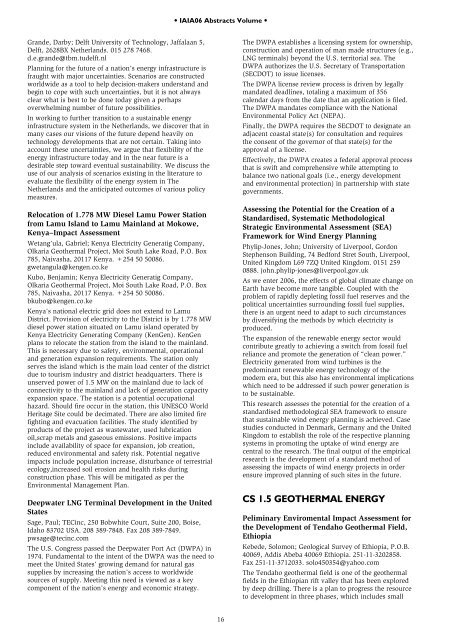

![Session Report [PDF] - International Association for Impact Assessment](https://img.yumpu.com/22416146/1/190x245/session-report-pdf-international-association-for-impact-assessment.jpg?quality=85)
![Session Report [PDF] - International Association for Impact Assessment](https://img.yumpu.com/22416140/1/184x260/session-report-pdf-international-association-for-impact-assessment.jpg?quality=85)
